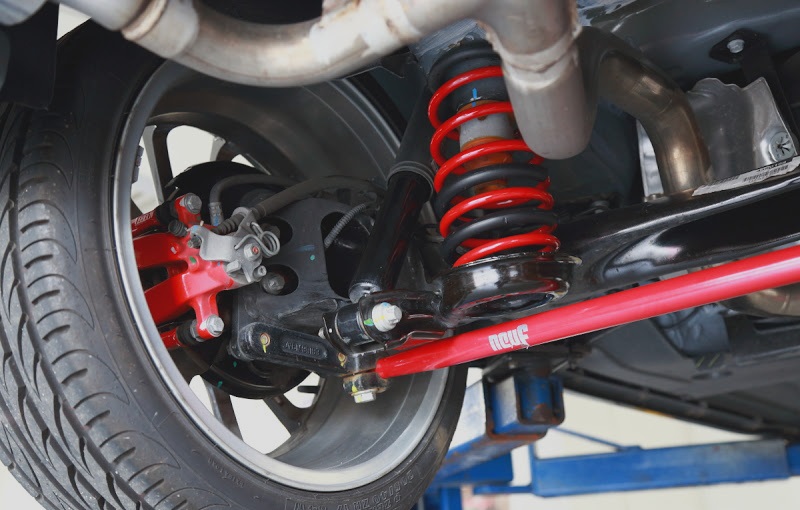The purpose of speed bumps is to slow down drivers and make neighborhoods safer and they do this effectively. Still, people have places to go and people to see and sometimes people hit a speed bump a little bit faster than they should.
The damage this can do to your vehicle should make hitting speed bumps too quickly not an option, though, even if there are no children at play. If you are driving without any skid plates, the risk from speed bumps is significantly worse.

Damage to Shock Absorbers
One of the many advantages to paying attention to the posted recommended speed when traversing over a speed bump is protecting your suspension system.
Your shock absorbers are made of springs with a valving system of gasses or oil to absorb any excess energy from the springs.
This system, although good for allowing you to feel less of the rough ground you’re driving on, cannot react quick enough for a pothole nor speed bump.

The reason you feel speed bumps and potholes is because of the shock absorber’s inability to accommodate that rapid of a change. Slowing down avoids this strain on your shock absorbers.
If you hit a speed bump or pothole fast enough, your shock absorber may begin to leak or its springs may become mishappen, rendering them ineffective.
Bad suspension does not only ruin the smooth ride of your vehicle. It may also make it less safe to drive since your suspension system improves vehicle handling.
Steering System Problems
The problems do not end there. If your shock absorbers fail because of hitting speed bumps at too rapid of a speed, you can very well cause alignment problems and other steering system issues. Like many things in life, one mishap can cause another, and another.

Under normal conditions, the typical vibrations that happen with driving is not a problem. With the increased bumpiness due to poor suspension capability, you can end up out of alignment or have your power steering suddenly go out on you due to a leak. It is not worth it.
Exhaust System Damage
Being one of the lowest parts of your vehicle, there is no question that your exhaust system is in danger when going over a speed bump too fast.
When your vehicle lands after going over the speed bump, there is a fairly good chance your exhaust system, important for both noise and emissions control, will come smashing into the pavement.

Like the problems that can occur with your steering due to bad suspension, the same can happen with your exhaust system.
Your exhaust system is mounted in such a way that it should be able to handle the normal jarring that comes with driving, though this ability is reduced if your shock absorbers have gone bad.
Shortened Lifespan of Tires
Driving slowly over speed bumps allows your tires to just roll right over them without any issues. When you drive faster, your vehicle will take the speed bump much harder.
The sidewalls of your tires may touch the ground or push out as it takes the weight of your vehicle coming down on the other side of the speed bump.
 Every time your sidewalls touch the ground, you are shortening the lifespan of your tires. Not only does it make it so you will have to get tires sooner than you would have otherwise, but it can also increase your risk of having a blowout!
Every time your sidewalls touch the ground, you are shortening the lifespan of your tires. Not only does it make it so you will have to get tires sooner than you would have otherwise, but it can also increase your risk of having a blowout!
Scraped Paint
So far, the damages we have covered are things that impact the function of your vehicle. This one, that happens all the time, is cosmetic in nature - - scraped paint.
If you have a low riding vehicle, have to go over particularly high speed bumps, or drive too quickly, the concrete speed bump may scrape your paint off of the edges and underside of your bumpers.
Repairing unsightly paint damage can be expensive, but without a bumper skid plate made specifically for this purpose, it may be needed. Even if the scrape is on the underside of your vehicle with none of the damage visible, it is not a good idea to leave it damaged.
With the constant contact with water splashing up from the ground, salt from icy roads, and debris flying at it, paint imperfections can encourage worse problems like rust.
How to Avoid Damage from Speed Bumps
Now you may be wondering what happens if you scrape the bottom of your car and how to avoid it, or how to avoid wrecking your suspension system because of speed bumps.
The main way to avoid damage from speed bumps, be it your tires, paint, steering, or shock absorbers, is to GO SLOWLY.
The majority of the risks associated with speed bumps are due to going too fast over them. Repairing damaged components so that you can get to where you are going a couple of seconds sooner is not worth it.
Everyone makes mistakes sometimes, but you should do your best to go over speed bumps at an appropriate speed for the sake of your vehicle, and the safety of the road.
There are a few circumstances where you may still have damage occur even if you are going slowly. For example, if you have to go over an abnormally tall speed bump and your vehicle’s factory undercarriage guards are missing, you will be more likely to damage your vehicle.
Of course, you should have a replacement installed regardless of how much car skid plates cost so that your undercarriage is protected.
